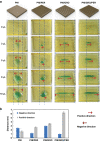Temperature-responsive peristome-structured smart surface for the unidirectional controllable motion of large droplets
- PMID: 37780811
- PMCID: PMC10539527
- DOI: 10.1038/s41378-023-00573-5
Temperature-responsive peristome-structured smart surface for the unidirectional controllable motion of large droplets
Abstract
The manipulation of fast, unidirectional motion for large droplets shows important applications in the fields of fog collection and biochemical reactions. However, driving large droplets (>5 μL) to move directionally and quickly remains challenging due to the nonnegligible volume force. Herein, we fabricated a scalable, bionic peristome substrate with a microcavity width of 180 μm using a 3D printing method, which could unidirectionally drive a large water droplet (~8 μL) at a speed reaching 12.5 mm/s by temperature-responsive wettability. The substrate surface was grafted with PNIPAAm, which could reversibly change its wettability in response to temperature, thereby enabling a temperature-responsive smart surface that could regulate droplet movement in real-time by changing the temperature. A series of temperature-responsive smart patterns were designed to induce water transport along specific paths to further realize controllable droplet motion with the antibacterial treatment of predesignated areas. The ability to achieve temperature-responsive unidirectional motion and dynamic control of droplet movement could allow programmable fluidic biosensors and precision medical devices. A temperature-responsive smart surface was produced to control the unidirectional motion of large droplets between spreading and pinning movement by changing the surface wettability.
Keywords: Chemistry; Microfluidics.
© Aerospace Information Research Institute, Chinese Academy of Sciences 2023.
Conflict of interest statement
Conflict of interestThe authors declare no competing interests.
Figures












Similar articles
-
Bioinspired Smart Peristome Surface for Temperature-Controlled Unidirectional Water Spreading.ACS Appl Mater Interfaces. 2017 Feb 15;9(6):5645-5652. doi: 10.1021/acsami.6b15802. Epub 2017 Feb 2. ACS Appl Mater Interfaces. 2017. PMID: 28106363
-
Three-Dimensional Maskless Fabrication of Bionic Unidirectional Liquid Spreading Surfaces Using a Phase Spatially Shaped Femtosecond Laser.ACS Appl Mater Interfaces. 2021 Mar 24;13(11):13781-13791. doi: 10.1021/acsami.0c22080. Epub 2021 Mar 11. ACS Appl Mater Interfaces. 2021. PMID: 33703880
-
Temperature-tunable wettability on a bioinspired structured graphene surface for fog collection and unidirectional transport.Nanoscale. 2018 Feb 22;10(8):3813-3822. doi: 10.1039/c7nr07728a. Nanoscale. 2018. PMID: 29412200
-
Stimuli-responsive surfaces for switchable wettability and adhesion.J R Soc Interface. 2021 Jun;18(179):20210162. doi: 10.1098/rsif.2021.0162. Epub 2021 Jun 16. J R Soc Interface. 2021. PMID: 34129792 Free PMC article. Review.
-
A Review of Smart Lubricant-Infused Surfaces for Droplet Manipulation.Nanomaterials (Basel). 2021 Mar 21;11(3):801. doi: 10.3390/nano11030801. Nanomaterials (Basel). 2021. PMID: 33801017 Free PMC article. Review.
Cited by
-
Reconfigurability-Encoded Hierarchical Rectifiers for Versatile 3D Liquid Manipulation.Adv Sci (Weinh). 2024 Oct;11(39):e2405641. doi: 10.1002/advs.202405641. Epub 2024 Jul 29. Adv Sci (Weinh). 2024. PMID: 39072942 Free PMC article.
-
Photo-responsive functional materials based on light-driven molecular motors.Light Sci Appl. 2024 Mar 1;13(1):63. doi: 10.1038/s41377-024-01391-8. Light Sci Appl. 2024. PMID: 38429259 Free PMC article. Review.
-
Comparison of Superhydrophilic, Liquid-Like, Liquid-Infused, and Superhydrophobic Surfaces in Preventing Catheter-Associated Urinary Tract Infection and Encrustation.ACS Biomater Sci Eng. 2024 Feb 12;10(2):1162-1172. doi: 10.1021/acsbiomaterials.3c01577. Epub 2024 Jan 6. ACS Biomater Sci Eng. 2024. PMID: 38183269 Free PMC article.
References
-
- Fan YY, et al. Bioinspired superhydrophobic cilia for droplets transportation and microchemical reaction. Adv. Mater. Interfaces. 2021;8:2101408. doi: 10.1002/admi.202101408. - DOI
-
- Cai ZX, et al. Programmable droplet transport on multi-bioinspired slippery surface with tridirectionally anisotropic wettability. Chem. Eng. J. 2022;449:137831. doi: 10.1016/j.cej.2022.137831. - DOI
LinkOut - more resources
Full Text Sources
